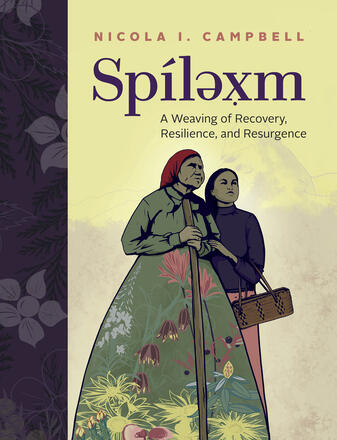As a grandmother and longtime teacher of young children, I'm delighted to share my enthusiasm for A Day with Yayah, a 2018 Crocodile Books release by award-winning author Nicola I. Campbell (Interior Salish), illustrated by another award-winner, Julie Flett (Cree-Metis).
A Day with Yayah
is a visual feast for fans of Julie Flett’s art, which just seems to get more amazing
all the time. Start with the cover, where a little girl in a yellow sweater
gazes into the face of a silver-haired woman. Both are seated on the ground and
surrounded by dark green grass, scattered flowers, and light blue sky.
Move to the endpapers with their seemingly simple, graceful
plants and insects. One more page-turn and there’s a bright yellow warbler-type
bird perched atop some tiny white flowers. On the facing page, the bird flies past
the title. Turn the page again and it sits above the dedications. The facing
page features another Indigenous child wearing red boots and a baseball-type cap,
holding a yellow flower. One more page turn, and Nicola Campbell’s story begins
as the little yellow bird looks on.
It’s springtime, and Nikki and her grandmother ("Yayah" in
their Indigenous language) are tanning a hide. (They’re the pair on the
cover.) Along come two kids from next door, eager for their lessons from Yayah.
She has been teaching them to identify edible wild plants AND to speak their Indigenous language, Nłeʔkepmxcin. She’s about to go gathering, and the kids want to go
along. Yayah packs them a lunch, phones their families, and soon they’re all
piled into Auntie Karen’s red minivan along with some other family members --
heading for a place where many significant plants can be found.
Flett’s illustrations show readers what a beautiful
day it is, and Campbell has Yayah teach the children “beautiful” in their
language. Yayah talks with them about specific plants – how they grow, their
uses, and what to avoid (like poison ivy). She uses the English names, but also tells them what those things are called “in our language,” and helps them with
their pronunciation (for example, one sound “is made at the back of your
throat”). Campbell weaves this vocabulary into the story multiple times, and many of the words are also set apart from the main text on the pages where they first appear, so child
readers who are learning the language have several chances to practice each one.
The story ends as the sun begins to go down, and the
children give the food they have gathered to their elders. On the next page is
Campbell's author’s note about Nłeʔkepmxcin, which is spoken by the Interior Salish people of what is currently known as
British Columbia. I can’t make the proper
spellings of the words because my keyboard lacks a lot of the characters.
Facing the author’s note is a glossary/pronunciation guide
to the words Yayah teaches in the story. On the final page before the end
papers, that little yellow bird is back on the white flowers.
This is probably the most beautiful “didactic” book I’ve
ever encountered. Yes, it's meant for teaching, but it also conveys a particular way of teaching and learning -- grounded in solid, caring Indigenous family/community relationships, and in profound respect for children's need to interact closely with things that are worth investigating in their world. I think children will relate well to the characters' curiosity and eagerness to find out more about words and about the natural world. There's even some humor to further enrich the book-sharing experience.
Speakers of Nłeʔkepmxcin reading today's post -- can you recommend a good resource for non-Salish adults who want to read aloud using the Nłeʔkepmxcin words in A Day with Yayah? The glossary and Campbell's in-text clues are extremely helpful, but some teachers may still hesitate to share it because of concern that they will mispronounce.
Of course, with help from the glossary, non-Salish readers can always simply substitute the English meanings as they read, and talk with the non-Salish children about the Nłeʔkepmxcin words without trying to say them. If they're fortunate enough to work with Salish families, one of the parents might be willing to do the reading. No matter what, it's essential for the teacher, parent, or librarian to model effective ways to encounter unfamiliar languages. Children who feel uncomfortable with "foreign" sounds and letters may giggle or mock. The adult's job is to show them how to meet the challenge of "not understanding" appropriately, with
1) humility ("I don't know this way of communicating but I can learn about it.")
2) respect ("This language is worth knowing more about it.") and
3) curiosity ("Wonder how I can find out more about it? Wonder what it would feel like to know what people are saying in that language?").
So far I haven't found recorded read-alouds of this book online. We can hope there will be some good ones soon!
Campbell has Yayah and the children thank the Creator for what they find. This seems to be done in a general way, perhaps a bit like saying grace before a meal, and does not appear to involve ceremonial matters that shouldn't be shared outside their Indigenous community. In her dedication, Nicola Campbell honors Auntie "E.I." Ethel Isaacs for "our childhood memories of traditional food gathering." She also thanks a woman who has been a champion for preservation of Nłeʔkepmxcin.
A Day with Yayah has all the features of an #ownvoices effort, and it’s strongly
recommended.





